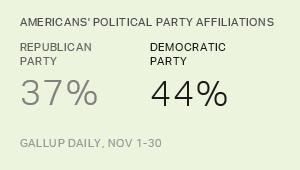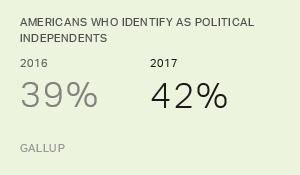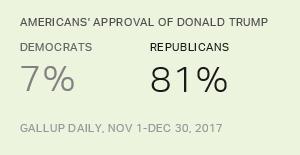Both major U.S. political parties recently held party conferences planning their strategies for the 2018 campaign. The stakes are high: control of the U.S. House of Representatives and, possibly, the U.S. Senate, as well as two-thirds of all state governorships.
The Democratic Party has been debating the development of a broader policy platform for the upcoming election -- one that extends beyond opposition to President Donald Trump. Some Democrats are now pushing for more robust messages constructed on specific policy differences with Republicans, in order to shift the battle lines for November 2018. According to a recent memo to the Democratic leadership by Priorities USA (a top Democratic super PAC), public support for Trump's tax reform law has gone up (Gallup recently found the same thing), which could force Democrats to re-examine their messaging in the coming months.
The Republican Party also must craft a more precise strategy that appeals to party loyalty, which has been somewhat inconsistent during Trump's first year in office. Republicans will have to motivate ardent Trump supporters to come out to the polls for GOP congressional candidates in 2018, rather than sitting back until 2020, when they can pull the lever again for Trump. The election will hinge on Republicans' ability to match or exceed Democrats' enthusiasm. The battle lines on the issues that will contribute to voter enthusiasm and, therefore, turnout, are slowly forming.
In each of the last three midterm elections -- 2006, 2010 and 2014 -- there has been a falloff of about 40 million voters compared with the prior presidential election.1 This has resulted in Republican base voters battling Democratic base voters in relatively small elections. A "base" or "core" voter is defined as one identifying with either the Democrats or the Republicans, with no leaning independents included. As recently as February of this year, Gallup tracking measured base Republicans as 25% of U.S. adults and base Democrats as 29%.
The lower voter turnout in midterm election years has produced three successive "political revolutions." In 2006, Democrats sufficiently motivated their base voters to regain control of the U.S. House and Senate; in 2010, Republicans won back the U.S. House; and in 2014, the Republicans again gained control of the U.S. Senate. All of these outcomes came about with comparatively low voter participation.
| 2012-2014 | 2008-2010 | 2004-2006 | |||||||||||||||||||||||||||||||||||||||||||||||||||||||||||||||||||||||||||||||||||||||||||||||||
|---|---|---|---|---|---|---|---|---|---|---|---|---|---|---|---|---|---|---|---|---|---|---|---|---|---|---|---|---|---|---|---|---|---|---|---|---|---|---|---|---|---|---|---|---|---|---|---|---|---|---|---|---|---|---|---|---|---|---|---|---|---|---|---|---|---|---|---|---|---|---|---|---|---|---|---|---|---|---|---|---|---|---|---|---|---|---|---|---|---|---|---|---|---|---|---|---|---|---|---|
| Presidential year | 130 | 133 | 124 | ||||||||||||||||||||||||||||||||||||||||||||||||||||||||||||||||||||||||||||||||||||||||||||||||
| Midterm year | 83 | 91 | 86 | ||||||||||||||||||||||||||||||||||||||||||||||||||||||||||||||||||||||||||||||||||||||||||||||||
| Falloff (presidential minus midterm) | -47 | -42 | -38 | ||||||||||||||||||||||||||||||||||||||||||||||||||||||||||||||||||||||||||||||||||||||||||||||||
| United States Elections Project | |||||||||||||||||||||||||||||||||||||||||||||||||||||||||||||||||||||||||||||||||||||||||||||||||||
Democratic Party leaders and the national media have commented about how the Democratic base voter is currently angry and motivated to reverse the Trump administration's policies. They believe that a "wave election" is in the offing for November 2018. But how many fewer voters will there be in 2018 than in 2016 (139 million),1 and will the opposition party achieve a disproportionate turnout to overwhelm the incumbents?
A term used in psychology to describe positive or negative stimuli that affect behavior is "valence." For example, anger toward the Trump administration has a negative valence, while support for Trump generally or on specific issues would have positive valences. In essence, both negative and positive emotions can cause behavior like "bothering to vote" in a nonpresidential election. A midpoint word would be "ambivalence," which is a conflict between positive and negative valence-carriers -- as in mixed emotions, inaction, gridlock or "just not bothering to vote."
Negative Valence Factors
Gallup measures satisfaction and dissatisfaction with various government policy domains every January to coincide with the annual presidential State of the Union address to the U.S. Congress. Respondents are asked whether they are "very satisfied," "somewhat satisfied," "somewhat dissatisfied" or "very dissatisfied" with a number of specific aspects of the country and government policy.
A gap in satisfaction with the issues between the base voters of one political party and the base voters of the other could influence differences in voter turnout between the parties. The biggest impact is likely to come from a mismatch on the percentages who are "very dissatisfied."
Given this, a potential strategy to drive up Democratic turnout would be to tap into the strong negative valences surrounding income inequality, efforts to deal with poverty, gun control, corporate power, race relations and affordable healthcare. As seen in this table, at least four in 10 Democrats are very dissatisfied with each of these issues, and Democrats have more than a 20-point edge over Republicans in extreme dissatisfaction on each.
| Republicans | Democrats | Net Democratic dissatisfaction | |||||||||||||||||||||||||||||||||||||||||||||||||||||||||||||||||||||||||||||||||||||||||||||||||
|---|---|---|---|---|---|---|---|---|---|---|---|---|---|---|---|---|---|---|---|---|---|---|---|---|---|---|---|---|---|---|---|---|---|---|---|---|---|---|---|---|---|---|---|---|---|---|---|---|---|---|---|---|---|---|---|---|---|---|---|---|---|---|---|---|---|---|---|---|---|---|---|---|---|---|---|---|---|---|---|---|---|---|---|---|---|---|---|---|---|---|---|---|---|---|---|---|---|---|---|
| % | % | pct. pts. | |||||||||||||||||||||||||||||||||||||||||||||||||||||||||||||||||||||||||||||||||||||||||||||||||
| Income inequality | 18 | 63 | +45 | ||||||||||||||||||||||||||||||||||||||||||||||||||||||||||||||||||||||||||||||||||||||||||||||||
| Efforts to deal with poverty/homelessness | 17 | 61 | +44 | ||||||||||||||||||||||||||||||||||||||||||||||||||||||||||||||||||||||||||||||||||||||||||||||||
| Gun laws | 16 | 57 | +41 | ||||||||||||||||||||||||||||||||||||||||||||||||||||||||||||||||||||||||||||||||||||||||||||||||
| Corporate influence | 15 | 48 | +33 | ||||||||||||||||||||||||||||||||||||||||||||||||||||||||||||||||||||||||||||||||||||||||||||||||
| Position of blacks/racial minorities | 11 | 40 | +29 | ||||||||||||||||||||||||||||||||||||||||||||||||||||||||||||||||||||||||||||||||||||||||||||||||
| Affordable healthcare | 29 | 53 | +24 | ||||||||||||||||||||||||||||||||||||||||||||||||||||||||||||||||||||||||||||||||||||||||||||||||
| Gallup, Jan. 2-7, 2018 | |||||||||||||||||||||||||||||||||||||||||||||||||||||||||||||||||||||||||||||||||||||||||||||||||||
On the Republican side of the equation, just one negative valence issue is evident in the January poll, but it's a key one: immigration. It carries a strong negative valence for Republicans, as 42% are very dissatisfied with the current level of immigration, more than 20 points higher than Democrats, at 20%.
| Republicans | Democrats | Net Republican dissatisfaction | |||||||||||||||||||||||||||||||||||||||||||||||||||||||||||||||||||||||||||||||||||||||||||||||||
|---|---|---|---|---|---|---|---|---|---|---|---|---|---|---|---|---|---|---|---|---|---|---|---|---|---|---|---|---|---|---|---|---|---|---|---|---|---|---|---|---|---|---|---|---|---|---|---|---|---|---|---|---|---|---|---|---|---|---|---|---|---|---|---|---|---|---|---|---|---|---|---|---|---|---|---|---|---|---|---|---|---|---|---|---|---|---|---|---|---|---|---|---|---|---|---|---|---|---|---|
| % | % | pct. pts. | |||||||||||||||||||||||||||||||||||||||||||||||||||||||||||||||||||||||||||||||||||||||||||||||||
| Level of immigration | 42 | 20 | +22 | ||||||||||||||||||||||||||||||||||||||||||||||||||||||||||||||||||||||||||||||||||||||||||||||||
| Gallup, Jan. 2-7, 2018 | |||||||||||||||||||||||||||||||||||||||||||||||||||||||||||||||||||||||||||||||||||||||||||||||||||
Positive Valence Factors
In terms of any grand strategy the Republican Party might use in the midterm elections, the economy and economic opportunity more broadly have positive valences with Republicans and may encourage GOP turnout. Republicans are largely content about the state of the country and may want to vote to "let the good times roll."
| Republicans | Democrats | Net Republican satisfaction | |||||||||||||||||||||||||||||||||||||||||||||||||||||||||||||||||||||||||||||||||||||||||||||||||
|---|---|---|---|---|---|---|---|---|---|---|---|---|---|---|---|---|---|---|---|---|---|---|---|---|---|---|---|---|---|---|---|---|---|---|---|---|---|---|---|---|---|---|---|---|---|---|---|---|---|---|---|---|---|---|---|---|---|---|---|---|---|---|---|---|---|---|---|---|---|---|---|---|---|---|---|---|---|---|---|---|---|---|---|---|---|---|---|---|---|---|---|---|---|---|---|---|---|---|---|
| % | % | pct. pts. | |||||||||||||||||||||||||||||||||||||||||||||||||||||||||||||||||||||||||||||||||||||||||||||||||
| Opportunity to get ahead through hard work | 57 | 17 | +40 | ||||||||||||||||||||||||||||||||||||||||||||||||||||||||||||||||||||||||||||||||||||||||||||||||
| Overall quality of life | 43 | 14 | +29 | ||||||||||||||||||||||||||||||||||||||||||||||||||||||||||||||||||||||||||||||||||||||||||||||||
| Gallup, Jan. 2-7, 2018 | |||||||||||||||||||||||||||||||||||||||||||||||||||||||||||||||||||||||||||||||||||||||||||||||||||
Additionally, 26% of Republicans are very satisfied with the economy, and a combined 81% are at least somewhat satisfied. At the same time, Democrats are fairly neutral on the economy, with equal numbers satisfied (50%) and dissatisfied (49%), and only 6% very satisfied. Thus, most of the intensity on this key pocketbook election issue is with the GOP.
Possible Nonissues
Several other policy evaluations -- shown in the following table -- could conceivably affect the 2018 elections, but probably won't because partisan attitudes largely offset each other. In other words, given equal intensity toward each issue, the Republican and Democratic base voters could cancel each other out, positive versus negative, to near zero. This issue set includes the environment, business regulation and energy policy.
| Republicans, total % satisfied | Democrats, total % dissatisfied | ||||||||||||||||||||||||||||||||||||||||||||||||||||||||||||||||||||||||||||||||||||||||||||||||||
|---|---|---|---|---|---|---|---|---|---|---|---|---|---|---|---|---|---|---|---|---|---|---|---|---|---|---|---|---|---|---|---|---|---|---|---|---|---|---|---|---|---|---|---|---|---|---|---|---|---|---|---|---|---|---|---|---|---|---|---|---|---|---|---|---|---|---|---|---|---|---|---|---|---|---|---|---|---|---|---|---|---|---|---|---|---|---|---|---|---|---|---|---|---|---|---|---|---|---|---|
| % | % | ||||||||||||||||||||||||||||||||||||||||||||||||||||||||||||||||||||||||||||||||||||||||||||||||||
| Environment | 69 | 67 | |||||||||||||||||||||||||||||||||||||||||||||||||||||||||||||||||||||||||||||||||||||||||||||||||
| U.S. world role | 66 | 71 | |||||||||||||||||||||||||||||||||||||||||||||||||||||||||||||||||||||||||||||||||||||||||||||||||
| Energy | 61 | 59 | |||||||||||||||||||||||||||||||||||||||||||||||||||||||||||||||||||||||||||||||||||||||||||||||||
| Business regulation | 48 | 58 | |||||||||||||||||||||||||||||||||||||||||||||||||||||||||||||||||||||||||||||||||||||||||||||||||
| Social Security and Medicare | 48 | 51 | |||||||||||||||||||||||||||||||||||||||||||||||||||||||||||||||||||||||||||||||||||||||||||||||||
| Gallup, Jan. 2-7, 2018 | |||||||||||||||||||||||||||||||||||||||||||||||||||||||||||||||||||||||||||||||||||||||||||||||||||
The second category of issues that might not come into play in the 2018 midterm elections would be those on which both political parties' base voters express similar levels of satisfaction and, therefore, lack the large spatial difference to create a higher turnout for one party. These include anti-terrorism efforts and military preparedness, about which majorities of both parties are broadly satisfied, as well as education and abortion, about which half or more in each party are broadly dissatisfied.
Bottom Line
Given the political parties' limited time and resources, to make their points, each will most likely target only two compelling messages for their national battle plan. The economic outlook issue is usually front and center in every campaign, and as of today, the advantage on the economy seems to be with the Republicans for 2018.
The Democrats have more messaging energy from traditionally secondary topics like policies for the poor, race relations and income distribution. Even though the midterm elections are eight months out, gun control could become a strong new message by November. The big question for Democrats is: Will focusing primarily on opposition to Trump be sufficient to ensure victory in 2018?
The strongest countervailing issue determining Republican turnout may be immigration. The level of immigration has a strong negative valence for the Republican base, in contrast to generating more mixed reactions from Democrats. Government and immigration are also the two highest-ranking issues in Gallup's February measure of the most important problems facing the United States, with government the clear top issue among Democrats (named by 28%) and immigration the leading Republican concern (29%). This indicates political energy behind these issues for each party. Despite all the other policies, new and old, that could be raised in any midterm election year, these two issues could well be the hardened combat zone for the 2018 midterm elections.
1 Source: United States Elections Project




